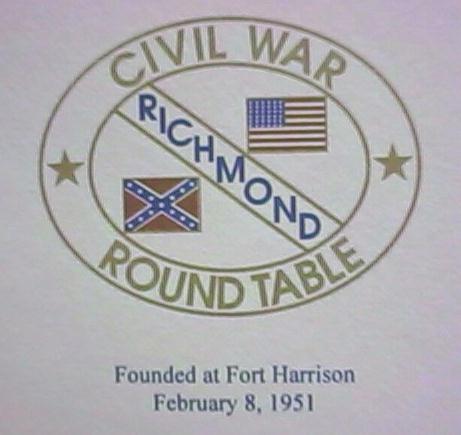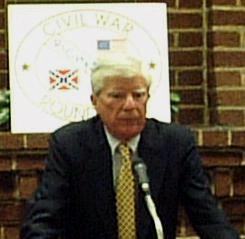


May 2001
Sam Craghead, President Art & Carol Bergeron, Editors 4361F Lakefield Mews 3901 Paces Ferry Road Richmond, VA 23231 Chester, VA 23831-1239 May 2001 PROGRAM Gary W. Gallagher "Coming to Terms with Defeat: Confederates in the Early Postwar Period" 8:00 p.m., Tuesday, May 8, 2001, at the Boulevard United Methodist Church, 321 N. Boulevard, Richmond, VA (corner of Boulevard and Stuart Ave.) Gary W. Gallagher is the John L. Nau III Professor in the History of the American Civil War at the University of Virginia. A native of Los Angeles, California, he received his B. A. from Adams State College of Colorado and his M. A. and Ph.D. from the University of Texas at Austin. He taught for twelve years at Penn State University before joining the faculty at the University of Virginia. Gallagher is the author and editor of dozens of books, including The Confederate War (1997), Lee and His Generals in War and Memory (1998), Fighting for the Confederacy: The Personal Recollections of General Edward Porter Alexander (1989), and Stephen Dodson Ramseur: Lee's Gallant General (1985). He has won numerous awards, including the 1990 Douglas Southall Freeman History Award for the best work in Southern history. Scholars over the past twenty years have devoted considerable attention to the question of why the Confederacy lost. Much of their work has emphasized fissures in Confederate society and concluded that the society crumbled from within before its armies had been decisively defeated. Gallagher will argue that those tensions were not the principal factor in bringing Southern defeat. He believes that the Confederacy capitulated in the Spring of 1865 because Union armies had demonstrated their ability to crush organized Confederate resistance. Confederates in and out of uniform did not reconcile easily to the harsh reality that the end had come and would have preferred a peace with Southern independence. Nevertheless, they accepted what seemed to them the unequivocal verdict of the battlefield. Later they would fashion a public memory of the war that gave meaning to their unimaginable loss and bitter defeat, but in April and May 1865, they realistically suppressed all thoughts of large-scale resort to arms.
How They Surrendered Professor Gary Gallagher and other scholars have argued that the Civil War ended because Confederate generals decided that their armies could no longer continue the conflict and not because of declining morale among the civilian population or decisions made by Confederate politicians. It seems appropriate to review when and where the Confederate forces capitulated. o General Robert E. Lee surrendered his Army of Northern Virginia to Lieutenant General Ulysses S. Grant at Appomattox Court House on April 9, 1865. o General Joseph E. Johnston surrendered the Army of the Tennessee and other forces in the Carolinas and Georgia to Major General William T. Sherman at Durham, North Carolina, on April 26, 1865. o Lieutenant General Richard Taylor surrendered the army of the Department of Alabama, Mississippi, and East Louisiana to Major General Edward R. S. Canby at Citronelle, Alabama, on May 4, 1865. o General Edmund Kirby Smith surrendered the army of the Trans-Mississippi Department to Major General Edward R. S. Canby at New Orleans, Louisiana, on May 26, 1865. o Brigadier General Stand Watie surrendered his command of Indian troops to Lieutenant Colonel Asa C. Matthews at Fort Towson, Indiana Territory, on June 23, 1865. This was the last organized Confederate land force to lay down its arms. o Captain James I. Waddell surrendered the C. S. S. Shenandoah to British authorities at Liverpool on November 6, 1865.
Review of the April ProgramErnest B. Furgurson presented an informative talk based upon his recent book Not War But Murder: Cold Harbor 1864. He described the battle as Ulysses S. Grant's worst defeat and Robert E. Lee's last great victory. The carnage left by the fighting was the worst Virginia had seen during the war. Never before were so many wounded soldiers left suffering on the field while generals worried about their own reputations. When Abraham Lincoln brought Grant east as commander-in-chief, he decided to let him run the war. Grant chose to get out of the political morass in Washington and to operate with Major General George G. Meade and the Army of the Potomac. Grant and Meade were not at all alike, and this led to tensions between the two generals. Meade became very resentful of Grant and, in letters to his wife, called him the "rising son." He felt that Grant was getting undue credit for victories that the army had won. Furgurson argued that Cold Harbor was a campaign, not just a single battle. It began with the cavalry clash at Haw's Shop on May 28 and ended on June 12, when Meade's army slipped away from its trenches and marched toward Petersburg. Following the Battle of the North Anna River, Grant had hoped to move his army southward and get to Richmond before Lee could intervene. Lee used his intelligence gathering forces well and was able to block the Federals near the road crossing at Cold Harbor. Grant drew reinforcements from Major General Benjamin F. Butler's Army of the James at Bermuda Hundred. At the same time, Lee brought troops from southern Virginia and the Shenandoah Valley to bolster his army. The two sides skirmished for several days before heavy fighting broke out on June 1. All this time, the Confederates were digging in. Grant's best opportunity occurred on June 2, but he could not get all of his attack elements in place on time. The main assault would not be launched until the following day. By the morning of June 3, the Confederate army was ready. It had improved its entrenchments so that they bent in a shallow crescent that would be able to pour a flanking fire into any attacking force. The assault came about 4:30 in the morning and stretched along a front of about six miles. Thousands of Federals were cut down without even coming close to the Confederate trenches. In one place, the attackers broke through Lee's line but were pushed back by a counterattack. The battle was over in about thirty minutes. Union losses are not know precisely but may have numbered close to 7,000 men killed, wounded, and missing. Not wishing to admit such a disastrous defeat, Grant refused to grant Lee's requests for a truce to bring in the wounded and bury the dead. Days passed, and hundreds of Federals died needlessly. According to Furgurson, both Grant and Meade shared blame for the debacle. Grant left the details of the assault to Meade, but the latter did not conduct a proper reconnaissance or organize the attack properly. Only after the battle did Meade learn that Grant had not been responsible for the reports in Northern newspapers and that he had not tried to slight the army commander. The effects of Cold Harbor were felt long afterwards. What has been called the "Cold Harbor syndrome" descended upon the Union army. When the troops reached Petersburg in mid-June, they refused to assault the prepared Confederate earthworks and let an easy victory slip out of their hands.
Announcements
New Round Table Raffle Our raffle has gotten better! Rather than simply taking a chance on some cash, members now have the opportunity to win a book. For those of you who missed the April gathering, we gave away a copy of Ernest Furgurson's new book on Cold Harbor. The prize at our May meeting will be Battle of Ball's Bluff: The Fateful Clash of North and South at Leesburg, Virginia, October 21, 1861, by Kim Bernard Holien. It is signed by the author. Proceeds from the raffle go toward battlefield preservation, so be ready to purchase a number of chances.
Fredericksburg National Cemetery Program On May 26, Fredericksburg and Spotsylvania County National Military Park will sponsor a luminaria at the Fredericksburg National Cemetery. Boy Scouts and Girl Scouts will place a luminaria at each of the 15,300 graves. The candles are lit at sunset, and a military bugler plays "Taps" every thirty minutes throughout the program, which runs from 8 p. m. to 11 p. m. Throughout the night, visitors are encouraged to stop at six different points of interest in the cemetery. At each stop, volunteers give a short, two-minute presentation about a certain aspect of the cemetery's history.
Summer History Courses Penn State University's Fayette Campus is offering two summer undergraduate history courses in conjunction with the Blue & Gray Education Society. Participants can earn three college credits. The first is History 297, Section 100, and will be held June 4-9 in Chattanooga, Tennessee. Presented by Dr. Stephen Woodworth, assistant professor at Texas Christian University, the class is "Studies in the American Civil War: The Struggle for Tennessee, from Tullahoma to Chickamauga." It will include classroom instruction and tours of historic sites. The second class is History 297, Section 101, and will be held July 16-21 at Gettysburg, Pennsylvania. Dr. Brooks Simpson, professor at Arizona State University, will lead "Decision at Gettysburg." This class also includes tours of the Gettysburg battlefield. For more information, call (724) 430-4215 or write to: Office of Continuing Education Penn State Fayette Campus P. O. Box 519 Uniontown, PA 15401-9962
Richmond Civil War Round Table Newsletter Art & Carol Bergeron, Editors 3901 Paces Ferry Road Chester, VA 23831-1239
Return to News Letters Index
Return to main page

©R.C.W.R.T. 2000-2001
